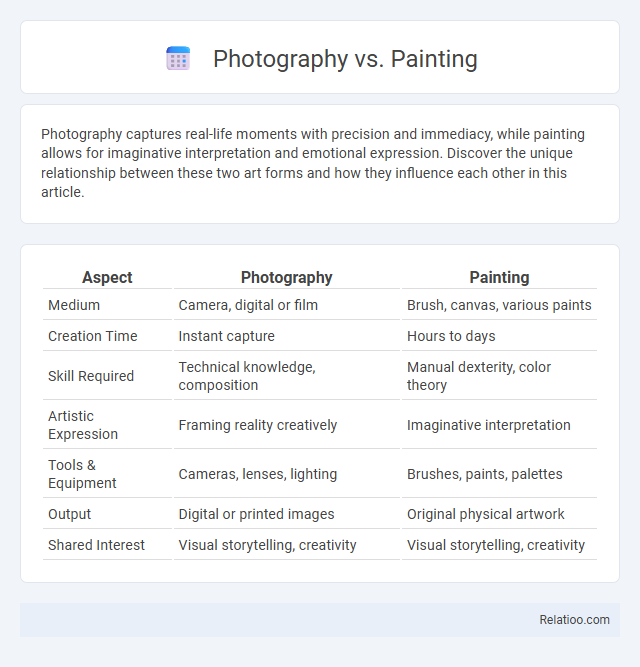Photography captures real-life moments with precision and immediacy, while painting allows for imaginative interpretation and emotional expression. Discover the unique relationship between these two art forms and how they influence each other in this article.
Table of Comparison
| Aspect | Photography | Painting |
|---|---|---|
| Medium | Camera, digital or film | Brush, canvas, various paints |
| Creation Time | Instant capture | Hours to days |
| Skill Required | Technical knowledge, composition | Manual dexterity, color theory |
| Artistic Expression | Framing reality creatively | Imaginative interpretation |
| Tools & Equipment | Cameras, lenses, lighting | Brushes, paints, palettes |
| Output | Digital or printed images | Original physical artwork |
| Shared Interest | Visual storytelling, creativity | Visual storytelling, creativity |
Introduction: Defining Photography and Painting
Photography captures moments through lenses, using light and technology to create realistic images. Painting involves applying pigments on surfaces to express creativity and emotions through brushstrokes and colors. Both serve as popular hobbies that allow individuals to explore artistic expression and visual storytelling.
Brief History of Both Art Forms
Photography emerged in the early 19th century with the invention of the camera obscura and daguerreotype process, revolutionizing visual art by capturing real-life moments instantly. Painting, dating back to prehistoric cave art and evolving through masterful techniques in the Renaissance and beyond, embodies human expression through brushstrokes and color. Your choice between photography and painting as a hobby reflects different creative approaches: photography leverages technology to freeze time, while painting emphasizes manual skill and interpretation.
Artistic Techniques: Camera vs. Brush
Photography employs precise camera settings like aperture, shutter speed, and ISO to manipulate light and capture moments instantly, creating realistic and detailed images. Painting relies on brush techniques such as blending, layering, and texture application to express emotions and abstract concepts, allowing for greater creative freedom and interpretation. Both mediums demand mastery over their tools, yet photography captures reality through lenses while painting constructs it through strokes of color and form.
Representation of Reality: Accuracy and Interpretation
Photography captures reality with precise accuracy by recording exact visual details, making it an ideal medium for documenting moments and scenes as they exist. Painting offers a more subjective interpretation, where artists can emphasize emotions, abstract elements, and personal perspectives, allowing for creative expression beyond mere replication. Your choice between photography and painting as a hobby depends on whether you prefer objective representation or imaginative reinterpretation of reality.
Emotional Impact and Viewer Experience
Photography captures authentic moments and emotions through light and composition, creating an immediate and relatable viewer experience. Painting allows for deeper emotional expression and interpretation through brushstrokes, color, and texture, engaging viewers' imagination and personal connection. As hobbies, both photography and painting foster mindfulness, creativity, and emotional well-being by allowing individuals to explore and communicate their inner feelings visually.
The Role of Technology in Both Mediums
Technology has revolutionized photography by enabling advanced digital cameras, editing software, and instant sharing platforms, enhancing creativity and accessibility for hobbyists and professionals alike. In painting, technology supports artists through digital tablets, virtual reality tools, and online tutorials that expand creative possibilities and skill development. Both mediums benefit from technological integration, which democratizes artistic expression and fosters innovative techniques in hobbyist communities.
Creativity and Artistic Freedom
Photography offers a unique blend of creativity and artistic freedom by allowing you to capture moments through framing, lighting, and perspective, making every shot a personal expression. Painting provides limitless possibilities in color, texture, and form, enabling artists to create entirely new worlds from their imagination without the constraints of reality. Both hobbies enhance creativity, but your choice depends on whether you prefer interpreting the world as it is or inventing one from scratch.
Cultural Significance and Influence
Photography captures cultural moments with precise realism, preserving historical events and everyday life for future generations. Painting, rooted in centuries-old traditions, often reflects the artist's personal interpretation of culture, symbolism, and societal values. Both hobbies influence cultural identity by fostering creativity, encouraging expression, and promoting appreciation for artistic heritage across diverse communities.
Contemporary Trends and Innovations
Contemporary trends in photography emphasize digital manipulation and AI-driven enhancements, pushing creative boundaries and offering versatile tools for artistic expression. Painting integrates mixed media and technology, such as augmented reality, to evolve traditional practices and engage audiences in immersive experiences. Your exploration of these hobbies benefits from understanding how innovations shape techniques and the artistic landscape, making both photography and painting dynamic, evolving forms of creativity.
Conclusion: Choosing Between Photography and Painting
Choosing between photography and painting depends on personal expression and preferred mediums; photography offers instant capturing of reality with technology, while painting allows tactile creativity and interpretation through brushstrokes. Both hobbies enhance artistic skills and emotional connection, but photographers rely on cameras and editing software, whereas painters develop techniques with various paints and canvases. Ultimately, embracing the medium that aligns with individual vision and workflow fosters the most rewarding creative experience.

Infographic: Photography vs Painting
 relatioo.com
relatioo.com